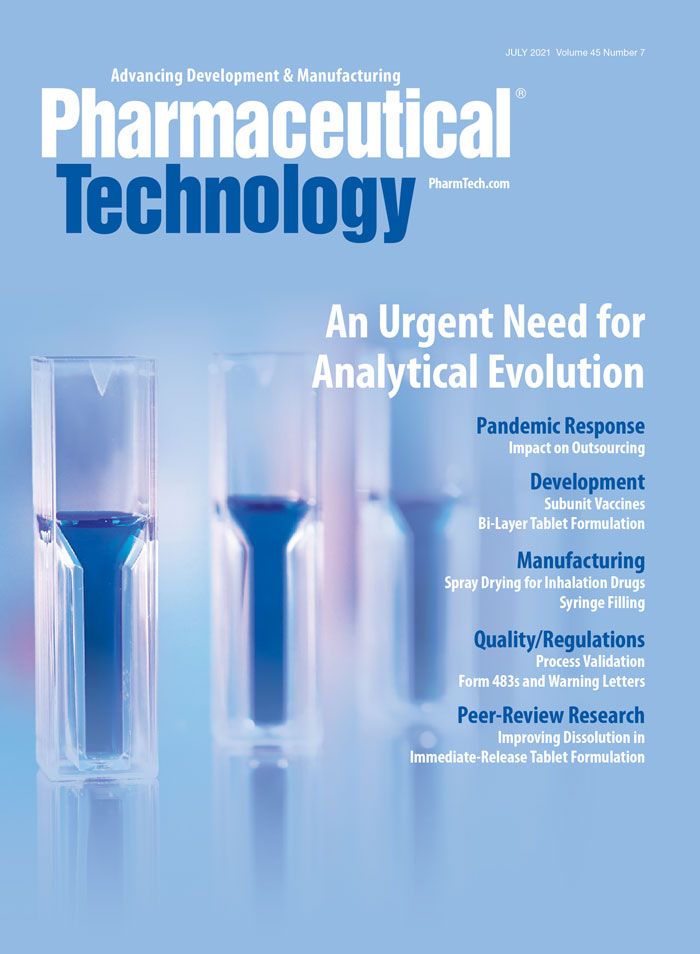Related story
Read the related cover story, "Complex Biomolecules Require Analytical Evolution," in the Pharmaceutical Technology July 2021 issue.
The future pipeline of complex novel biotherapeutics will require new approaches to analytical assessment.
Novel biotherapeutics are expected to have higher heterogeneity (variants); learning and understanding what these variants are will increase assurance of product consistency, says Pedro Morales, director, Catalent Biologics. He explains that massive genomics and proteomics data will need to be correlated with functionality data to identify what is truly critical to set specifications for release. “The establishment of proteomics and genomics databases are also a challenge as one needs to consider not only the product, but the genetic makeup of the patient as part of the correlation. Next-generation sequencing will be crucial to the implementation of cell and gene therapies (CGTs) because of the nature of personalized medical approaches,” Morales says.
Read the related cover story, "Complex Biomolecules Require Analytical Evolution," in the Pharmaceutical Technology July 2021 issue.
As the industry moves gradually towards more personalized biotherapeutics, the ability to craft a biotherapeutic for each patient in real-time becomes more of a reality, asserts Christopher Colangelo, biopharma business development leader, Agilent Technologies. He states that there is a need, however, to scale and commoditize lab analytical workflows so that the same robust purification and critical quality attributes characterization can be performed at a lower cost per sample, without compromising sample or data quality.
Decreasing the cost of developing immunotherapeutic modalities, especially those based on CGT approaches, will be essential for their broad adoption, says Jana Hersch, scientific consultant, Genedata. “Innovative digitalization and new manufacturing practices will provide key solutions. New and enhanced digital solutions are already becoming available to support CGTs. Since cell and gene therapies often serve relatively small patient populations, miniaturization with patient-scale manufacturing represents another tangible step towards lowering costs,” she says.
“While these technologies predated the therapeutics, mechanisms to manage the data generated from these analytical approaches and to validate the instruments’ software for GMP [good manufacturing practice] testing is lacking. For nucleic acid sequencing, whole genome and single cell-based sequencing platforms continue to evolve with new, powerful software tools to support data analysis,” Marc Wolman, principal scientist at PPD Laboratories’ GMP Lab says. These tools, however, require substantial manual intervention and analyst interpretation when performing the analysis or retrieving sequencing data from tangential databases, he specifies.
“If techniques like AUC [analytical ultracentrifugation] and NGS [next-generation sequencing] are to become mainstream GMP methodologies, then innovations in data management and analytics regulations must be developed and implemented to meet CFR 21 compliance,” Wolman concludes.
The methods used to characterize, inform, and select the best biologic drug candidates are becoming more complex, requiring different analytical parameters to be assessed, observes Campbell Bunce, chief scientific officer at Abzena, who reinforces the need for speedy analysis with emerging drug platforms. For example, in the context of personalized cell therapies, a fast turnaround time from cell collection, modification, scale up, and treatment are critical to the patient outcome. “Innovative means of applying sophisticated analytics to these complex therapeutics in a fast and efficient way is required to help streamline the manufacturing process to increase the chances of success and pre-empt or reduce safety risks” he says.
Feliza Mirasol is the science editor for Pharmaceutical Technology and Pharmaceutical Technology Europe.
Pharmaceutical Technology
Vol. 45, No. 7
July 2021
Page: 22
When referring to this article, please cite it as F. Mirasol, “Meeting Future Analytical Requirements for Novel Biotherapeutics” Pharmaceutical Technology, 45 (7) 22 (2021).

Drug Solutions Podcast: A Closer Look at mRNA in Oncology and Vaccines
April 30th 2024In this episode fo the Drug Solutions Podcast, etherna’s vice-president of Technology and Innovation, Stefaan De Koker, discusses the merits and challenges of using mRNA as the foundation for therapeutics in oncology as well as for vaccines.
Drug Solutions Podcast: Applying Appropriate Analytics to Drug Development
March 26th 2024In this episode of the Drug Solutions Podcast, Jan Bekker, Vice President of Business Development, Commercial and Technical Operations at BioCina, discusses the latest analytical tools and their applications in the drug development market.